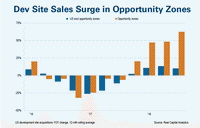An IRS hearing this week focused on how Opportunity Zone regulatory guidance may affect long-term investments in certain low-income communities. The hearing, originally scheduled for Jan. 10, was rescheduled due to the government shutdown in December.
 |
|
An IRS hearing this week focused on how Opportunity Zone regulatory guidance may affect long-term investments in certain low-income communities. |
- Earlier in the week, a delegation from The Real Estate Roundtable’s Opportunity Zone Working Group met with Treasury officials to discuss proposed and forthcoming tax regulations. The meeting addressed key areas where additional guidance could help ensure the Opportunity Zone tax incentives succeed in stimulating productive, job-creating real estate investment in the designated low-income communities. Among the issues discussed:
- Determining what constitutes the original use of property for Opportunity Zone purposes, and in particular, whether a Qualified Opportunity Fund can purchase a newly constructed building before it is placed in service;
- Clarifying how land is treated for purposes of the Opportunity Zone asset test, and how to account for leased property;
- Facilitating contributions of real property to Opportunity Funds by current property owners
- Ensuring that capital gain in multi-asset Opportunity Funds can qualify for the tax incentives;
- Clarifying the tax consequences of refinancing and debt distribution transactions, particularly those that involve appreciated Opportunity Zone assets;
- Encouraging capital formation and growth in Opportunity Zones through favorable gain reinvestment, roll-over, and holding period rules at the investor, fund and business level; and
- Enhancing the 31-month working capital safe harbor through additional safeguards and relief for fund investors making a good faith effort to deploy their capital.
 |
|
Sen. Tim Scott (R-SC) led the effort in Congress for enactment of the Opportunity Zones program. |
Similar issues were raised by 23 witnesses at the five-hour IRS hearing on Thursday. (Bisnow, Feb. 14).
- A letter on Feb. 5 from Senators Chris Coons (D-DE) and Michael Bennet (D-CO) to Treasury Secretary Steven Mnuchin raised additional issues and expressed concerns regarding the potential for waste and abuse, including in the context of real estate investment. (Delaware Business Now, Feb. 6).
- The Opportunity Zone program’s goals and incentives were the focus of a Jan. 29 discussion during The Roundtable’s State of the Industry Meeting, which featured Sen. Tim Scott (R-SC) – who led the effort in Congress for enactment of the program – and Roundtable member Geordy Johnson (CEO, Johnson Development Associates, Inc.).
- Sen. Scott and the original co-sponsors of the Investing in Opportunity Act sent a bipartisan letter to Treasury Secretary Mnuchin on Jan. 24, urging Treasury to clarify its initial set of regulations, particularly as it relates to operating businesses. (Congressional Letter to Treasury, Jan. 24).
- The Real Estate Roundtable provided formal comments on Dec. 19, 2018 that encouraged Treasury and the IRS to clarify certain tax issues for potential Opportunity Zone (OZ) investors and Qualified Opportunity Zone managers. The letter was the second round of Roundtable comments following Treasury’s initial set of proposed OZ regulations issued last October. (Roundtable Weekly, Oct. 21, 2018 and Dec. 19, 2018)
The highly-anticipated, second set of Treasury OZ regulations are expected in the coming weeks. Another public hearing will follow before rules for the program are finalized.






